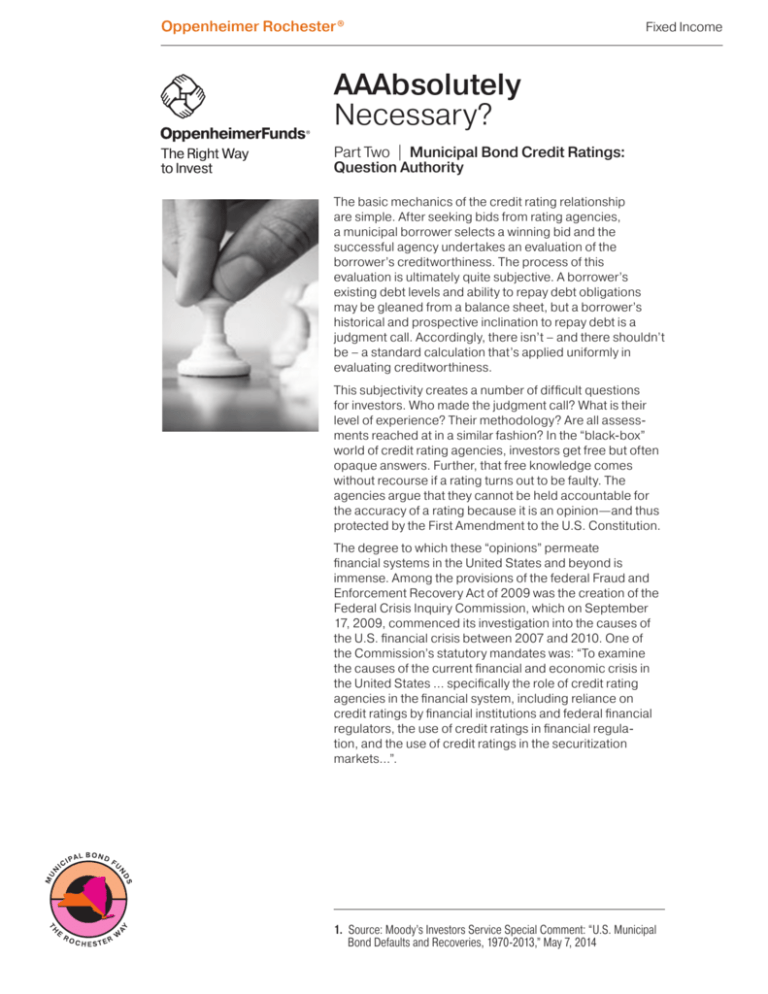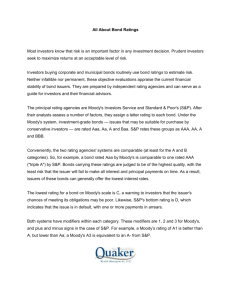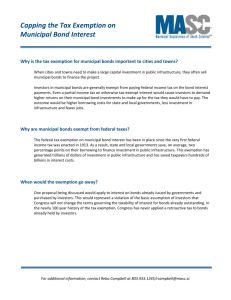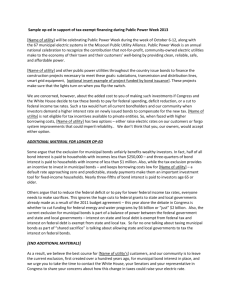
Oppenheimer Rochester ®
Fixed Income
AAAbsolutely
Necessary?
Part Two | Municipal Bond Credit Ratings:
Question Authority
The basic mechanics of the credit rating relationship
are simple. After seeking bids from rating agencies,
a municipal borrower selects a winning bid and the
successful agency undertakes an evaluation of the
borrower’s creditworthiness. The process of this
evaluation is ultimately quite subjective. A borrower’s
existing debt levels and ability to repay debt obligations
may be gleaned from a balance sheet, but a borrower’s
historical and prospective inclination to repay debt is a
judgment call. Accordingly, there isn’t – and there shouldn’t
be – a standard calculation that’s applied uniformly in
evaluating creditworthiness.
This subjectivity creates a number of difficult questions
for investors. Who made the judgment call? What is their
level of experience? Their methodology? Are all assessments reached at in a similar fashion? In the “black-box”
world of credit rating agencies, investors get free but often
opaque answers. Further, that free knowledge comes
without recourse if a rating turns out to be faulty. The
agencies argue that they cannot be held accountable for
the accuracy of a rating because it is an opinion—and thus
protected by the First Amendment to the U.S. Constitution.
The degree to which these “opinions” permeate
financial systems in the United States and beyond is
immense. Among the provisions of the federal Fraud and
Enforcement Recovery Act of 2009 was the creation of the
Federal Crisis Inquiry Commission, which on September
17, 2009, commenced its investigation into the causes of
the U.S. financial crisis between 2007 and 2010. One of
the Commission’s statutory mandates was: “To examine
the causes of the current financial and economic crisis in
the United States … specifically the role of credit rating
agencies in the financial system, including reliance on
credit ratings by financial institutions and federal financial
regulators, the use of credit ratings in financial regulation, and the use of credit ratings in the securitization
markets…”.
1. Source: Moody’s Investors Service Special Comment: “U.S. Municipal
Bond Defaults and Recoveries, 1970-2013,” May 7, 2014
Oppenheimer Rochester ®
In January 2011, following numerous hearings conducted over the previous 2 years, the
Commission reported its findings. Concluding
that Standard and Poor’s, Fitch Publishing
Company and Moody’s Investors Service credit
ratings were central to the financial crisis, the
final report states, in part:
“We conclude the failures of credit rating agencies were essential cogs in the wheel of financial
destruction. The three credit rating agencies
were key enablers of the financial meltdown. The
mortgage-related securities at the heart of the
crisis could not have been marketed and sold
without their seal of approval. Investors relied
on them, often blindly. In some cases, they were
obligated to use them, or regulatory capital
standards were hinged on them. This crisis could
not have happened without the rating agencies.
Their ratings helped the market soar and their
downgrades through 2007 and 2008 wreaked
havoc across markets and firms.”
Even a Stacked Deck Loses
Sometimes
While the historical dearth of municipal bond
defaults provides rating agencies a substantial
head start on being “correct” (risk-averse
investors tend to accept the validity of a rating
that appears too low), the instances where
municipal bond ratings proved to be overly
optimistic have been dramatic – and costly.
The murky “subjective” branch of a credit rating
may or may not take into account a variety of
factors that quantitative measurement (i.e.,
balance sheet evaluation) decidedly cannot.
Macroeconomic developments over time,
feasibility, mismanagement, willingness to pay
and natural or man-made disasters are a mere
handful of factors that might impact the likelihood of a municipal bond’s default, but can
bear little relation to the raw numbers appearing
before an analyst.
Municipal bonds issued to finance construction
of nuclear reactors for the Washington Public
Power Supply System (“WPPSS”) offer a historic
Fixed Income
example of an overly optimistic credit rating. In
1976, 88 public utilities in the U.S. Northwest
agreed to purchase from WPPSS a share of the
capacity of nuclear power projects, and to pay
their share of the plants’ finance, construction
and operating costs. Over the next 5 years,
WPPSS issued $2.5 billion in municipal bonds to
finance the projects. But even while the bonds
were still being sold to investors, an unexpected
event severely interrupted the work: demand
projections for electric power grew more slowly
than originally predicted. This factor, combined
with large cost overruns, resulted in the ultimate
failure of two of the financed projects.
With public faith in nuclear power declining
and interest in energy conservation increasing,
private institutions began to question the original investment-grade ratings that had been
assigned by Moody’s and S&P. Moody’s had
initially assigned the bonds an investment-grade
rating of A1; by January of 1982, Moody’s
had reduced that rating once and temporarily
suspended it. By June of the following year,
Moody’s withdrew its credit rating entirely. S&P
had initially assigned a rating of A-plus, but by
the summer of 1983, after a series of rating
decreases, S&P lowered its rating to D –
indicating “Default.” The power plants were
doomed. The bonds defaulted and approximately 30,000 bondholders lost between 60
and 90 cents on each dollar of their investment.
The WPPSS bond debacle was a significant
development in the municipal bond market for
a variety of reasons. Not only did this largest
municipal bond default generate a tsunami of
litigation and a class-action lawsuit that spanned
7 years from its inception in 1983, it greatly
improved the lot of municipal bond insurers.
Ambac had insured a small portion of WPPSS
bonds (possibly because of the original investment-grade ratings) and owners of the insured
bonds received timely payment on their bonds
– in full. Accordingly, insured municipal bonds
became tremendously popular with investors.
Oppenheimer Rochester ® Ironically, ratings agencies also assisted in
ending the era of municipal bond insurance;
insuring “structured finance products” with
investment-grade credit ratings, including
collateralized debt obligations (CDOs) and mortgage-backed securities, led to decreases in the
credit ratings of the insurers themselves when
those securities proved non-viable. Having lost
their AAA credit ratings, municipal bond insurers
found themselves without a means of selling
new insurance policies. Today, relatively few
new municipal bonds reach the market with
an insurance policy attached.
But credit rating errors can also have a bright
side for investors who have rigorous credit
research capabilities. A bond’s rating can
prove to be unjustifiably low, contributing to
market pricing inefficiency and creating an
opportunity for the investor who understands
the bond. In September 2012, for example,
investors in Tuscaloosa (Alabama) Education
Building Authority benefited from this condition. The college, which had a long history of
paying its debts despite occasional financial
challenges, received a warning in 2011 about
its accreditation status. That same year, credit
rating agencies downgraded the municipal
bonds that had been issued to finance housing
at Stillman College to “junk” status (i.e., below
investment-grade).
For investors in the newly designated “junk
bonds,” however, this development had little
impact. Stillman College was awarded a
low-cost loan from the U.S. Department of
Education to refinance the bonds and, on
September 14, 2012, investors tendered their
bonds at a price of $101. This is one example of
where the Rochester municipal investment team
saw opportunity; rating agencies clearly did not.
Conclusion
A bond’s credit rating, high or low, cannot
provide a complete picture of a bond issuer’s
creditworthiness. Higher or lower ratings can
be equally misleading for investors who are not
Fixed Income
equipped to conduct their own research into the
terms and structure of a bond. The fact that bond
issuers pay for ratings – and that rating agencies
bid for the right to provide them – creates the
question of subjectivity.
The U.S. Securities and Exchange Commission
(“SEC”) has recently been charged with examining this question. On July 21, 2010, in response
to the recession that ended in June 2009, the
Dodd-Frank Wall Street Reform and Consumer
Protection Act became law. Under the law, the
SEC was required to launch an Office of Credit
Ratings (the “OCR”); the office opened in June
2012 with a staff of about 25 lawyers, accountants and examiners.
Based on its initial examination of possible
conflicts of interest arising out of the “issuer
pays” model of compensation, the OCR reported
that it had found weaknesses in managing
conflicts at some credit rating agencies. The
report also raised concerns about a variety of
topics, including the supervisory practices at
some credit rating agencies. To date, the SEC
has not named the firms at which it said it found
weaknesses. The SEC has also been studying
several alternative compensation models
furnished by the U.S. Government Accountability
Office, an independent, nonpartisan agency that
works for Congress.
Regardless of who pays for them, credit ratings
in some form will probably be around for a long
time. The professional opinions rendered by
the NRSROs are likely to remain fairly opaque
as each agency applies its own qualitative and
quantitative judgments in assessing an issuer’s
creditworthiness.
We believe that investors are best served if they
have access to or can conduct an independent
analysis of any municipal bond they are considering. Given the co-dependent relationship
that currently exists between issuers and credit
rating agencies – and the downward bias that we
believe credit rating agencies inherently possess
– investors should not be particularly surprised
when independent analysis points to a very
different conclusion.
Oppenheimer Rochester ® Visit Us
oppenheimerfunds.com
Call Us
800 225 5677
Follow Us
Fixed Income
Fixed income investing entails credit and interest rate risks. Interest rate risk is the risk that rising interest rates, or an
expectation of rising interest rates in the near future, will cause the values of a Fund’s investments to decline. Risks
associated with rising interest rates are heightened given that rates in the U.S. are at, or near, historic lows. When interest
rates rise, bond prices fall and a fund’s share price can fall. Municipal bonds are subject to default on income and principal
payments. Further, a portion of some funds’ distributions may be taxable and may increase alternative minimum tax (AMT)
for investors subject to that tax; distributions from net realized capital gains are taxable as capital gains. The funds invest in
below-investment-grade debt securities, which may entail greater credit risks, as described in each fund’s prospectus. These
securities (sometimes called “junk bonds”) may be subject to greater price fluctuations and risks of loss of income and
principal than investment-grade municipal securities. The funds may invest substantially in municipal securities within a single
state or related to similar type projects, which can increase volatility and exposure to regional issues. The funds may also
invest substantially in Puerto Rico and other U.S. territories, commonwealths and possessions, and could be exposed to their
local political and economic conditions
Shares of Oppenheimer funds are not deposits or obligations of any bank, are not guaranteed by any bank, are
not insured by the FDIC or any other agency, and involve investment risks, including the possible loss of principal
amounts invested.
Before investing in any of the Oppenheimer funds, investors should carefully consider a fund’s
investment objectives, risks, charges and expenses. Fund prospectuses and summary prospectuses
containing this and other information may be obtained by asking your financial advisor, visiting
oppenheimerfunds.com, or calling 1.800.CALL OPP (225-5677). Read prospectuses and summary
prospectuses carefully before investing.
Deterioration of the Puerto Rican economy could have an adverse impact on Puerto Rican bonds and the performance of
the Rochester municipal funds that hold them.
Oppenheimer funds are distributed by OppenheimerFunds Distributor, Inc., 225 Liberty Street, New York, NY 10281-1008
© 2015 OppenheimerFunds Distributor, Inc. All rights reserved.
RW2947.013.0415 May 1, 2015







